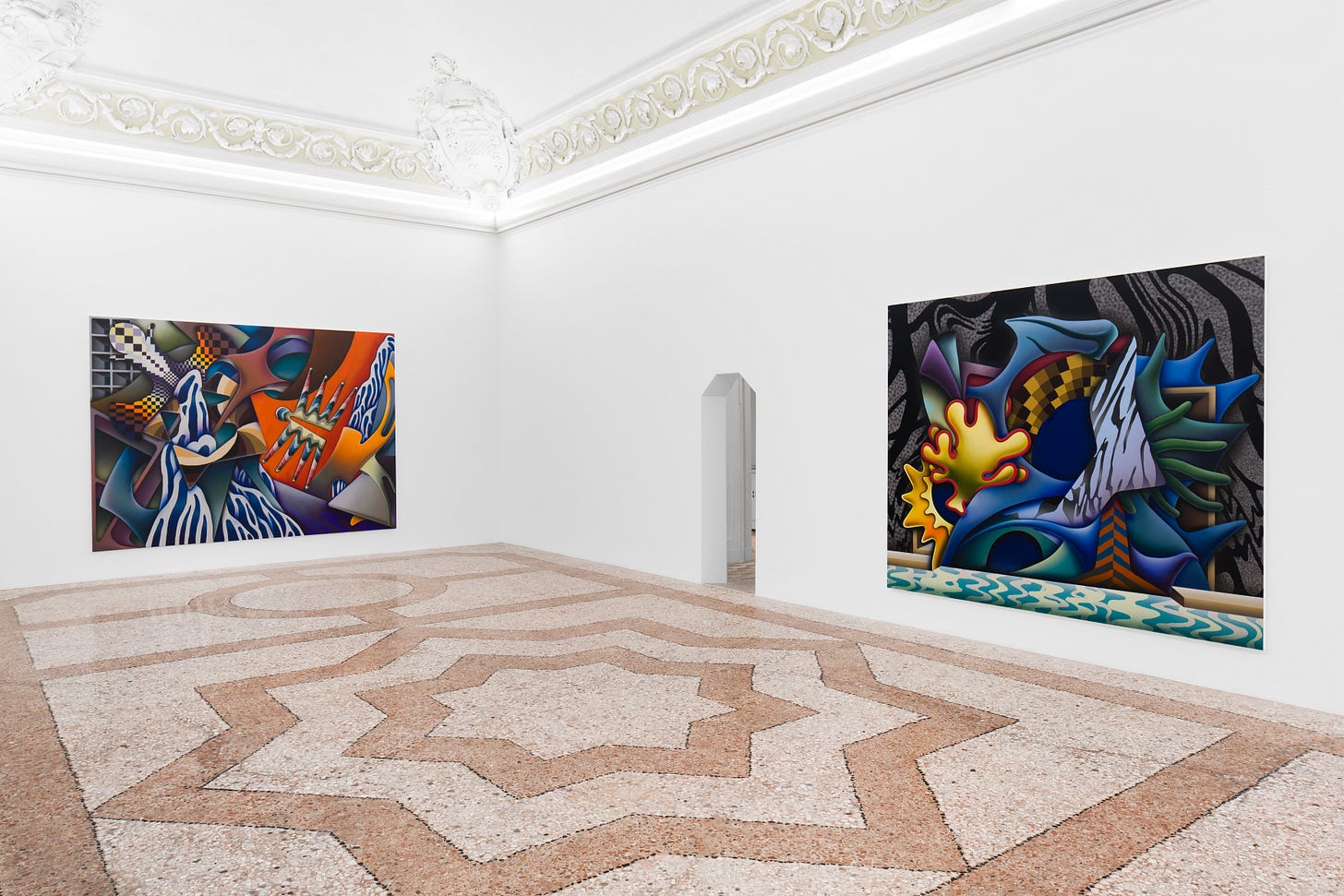Liquid Marble Mechanics: Harm Gerdes at Peres Projects Milan
Freestyling some artistic technique classics, Harm (Millennial, German) brings nostalgic futurism into his paintings.
Everything all at once
Harm’s paintings are neither fully abstract, nor certainly figurative. They are rather both simultaneously. Fluid, gooey shapes that almost turn slippery liquid are interlocked with hard shiny metallics. In an unexpected way, these cold steel surfaces remind me of Konrad Klapheck (1935-2023, German). As if Harm sampled Konrad’s glossy, minimalist machines, bent their shells and gear wheels, and threw them all together.
Space is tricky. Sidereal Bouquet (2024) seems to have a fore-, back-, and middleground with a bouba/kiki pile in the center pushed close to the edge of a river or basin. The dark monochrome background can be anything from an oil spill to TV static. While the shadows suggest depth and the twisted and intertwined forms allude to impossible M.C. Escher (1898-1972, Dutch) type beat architectural forms, their combination doesn’t allow any final conclusions.
Looking at the texture variety, it’s surprising that all paintings are made with nothing but acrylic that the artist applies by pouring and airbrushing. Harm uses a paintbrush only for touch ups here and there.

Hard Edge or Edging Hard?
Let me be especially bold today and introduce a new concept to you: Harm’s works are Neo Hard Edge. Yes, I just made that up. Now let me cook. 20th century Hard Edge painters were focussed on the painting surface being overall smooth and void of any brushstrokes or other traces resulting in a slickness that looks rather stenciled or printed. Harm is partly using the same techniques. Just like the American Hard Edge painters, he layers tape creating (almost) perfect contours when stripped away. But Harm goes beyond the classical Hard Edge concept. Instead of evening everything out until all parts look the same, he introduces conflicting textures on the same picture plane.
Harm pours acrylic right onto the smooth polymer canvas, molding it into marble or multichromatic liquids. In Hallucinations (2023). The dark blue patches close to the lower edge might be a solid marble wall, although their lighter striped counterparts suggest a waterfall. Rosy and brown liquids return in the upper half. These sections don’t simply look liquid because they hardened into the poured form. They seem to coat the geometric elements around them, cascading, pulled downwards by the gravity of the painted realm.

A texture encyclopedia
The digital world is alive and well in Harm’s works. Poured rectangles range from disco balls as in Sidereal Bouquet to a pixelated PNG background in Agape Halfway (2024). The grey grid structure in its upper left corner reminds me of Brutalist concrete architecture. Back in Sidereal Bouquet, Harm makes the blue in the center look like wood. He turns paint into camouflage, squishy fabric, ice cream, silicone, plastic, and whatever else you want it to be.
This variety of surfaces doesn’t allow for full control over the results. Paint might crack if left too long to dry or slightly flow over into another section. The smoothness from afar is disrupted by irregular contours or edges underneath another hardened layer. While historical Hard Edge painters avoided all texture, our artist doesn’t see no harm in it. Sorry for the atrocious pun, broski…

Echo, Iridescent (2024) held my attention the longest. The vertical canvas reveals a sharp teal carcass embracing an elastic alien skelleton from the pelvis upwards. The raised shoulders resemble Leonardo Da Vinci’s (1452-1519, Italian) Vitruvian Human (c. 1490). Harm’s use of gradients and metallic sheen here brings to mind The Brooklyn Bridge: Variation on an Old Theme (1939) by Joseph Stella (1877-1946, American). Empty spaces in between expose a linear geometric backdrop that is surprisingly similar to the pattern of the gallery’s terrazzo floor. Although Harm’s motives are futuristic, they fit pretty well into spaces marked by time. Looks like he’s getting the best of both worlds.
Harm Gerdes: The Autotuned Mind was on view from April 24 through May 31, 2024, at Peres Projects, Milan.
Peres Projects
Piazza Belgioioso 2
20121 Milan
Website
Instagram: @peresprojects @harmgerdes
Last time I’ve been to Milan was almost 10 years ago, so it’s refreshing to see the city with new eyes. What do you think of Harm’s show? Leave a like, maybe even a comment, and please share with someone who you think would enjoy this one.
See you soon!!!
Jennifer
The Gen Z Art Critic




